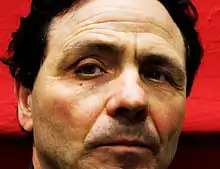Cesare Berlingeri | |
|---|---|
 Cesare Berlingeri | |
| Born | 1948 |
| Nationality | Italian |
| Known for | Drawing, Painting, Sculpture |
| Notable work | paintings, sculptures, performance |
| Movement | contemporary art |
Cesare Berlingeri (born 1948) is an Italian contemporary artist, mostly known for his folded paintings[1]
Artistic career, the first stages
In 1968 Berlinghieri made several trips around Europe, met other artists and became better acquainted with the world of contemporary culture. In Rome, in the 1970s. he began working for the theatre and television (also with RAI, the Italian public national television).[2] In these artistic phase he sought an expressive path of his own by experimenting different methods and ways of painting, using natural elements such as wind, rain and fire – a means of introducing randomness and materials such as lime, cement, waste paper and canvas. In the late ‘70s he began working on the “Trasparenze”, which followed the “Strappi” cycle, reconfirming his constantly evolving-transforming study on canvas. The Trasparenze represent “research into canvas and its penetrability, on the visibility of what is beyond the fabric: an attempt not to make the visibility system stiff” C. Benincasa.[3] These works consist of ultra-light and superimposed linen canvases, meaning the superimposition of transparent surfaces that make reference the one to the other and do not hide the colour fragments and small folded fabrics they enclose. This cycle was presented in 1979 at the Soligo Gallery in Rome and at the City Gallery of Saint Vincent. C. Vivaldi mentioned the artist in the Bolaffi catalogue (1980) as follows: ”I have pleasure in presenting a young artist from Calabria who, though living in a small town, fits perfectly into the mainstream of international culture. This is an artist with a sure future.” In 1985, he participated in the exhibition entitled “5 mosaici per 5 artisti”, together with Mario Schifano, Mafonso, Parres and Tano Festa.[4] During the ‘80s and ‘90s theatre cooperation intensified in the fields of installations, sets and costumes design.[5]
The Master of the “Piegature”
The folded paintings were exhibited in 1990, after a meeting with Tommaso Trini who wrote: ”I remember that when I visited the Taurianova workshop, during the preparation of a large exhibition at Messina, Berlingeri was still debating the puzzlement of his supporters, most of whom were convinced that “those objects” were out of style. But I was straight away excited”.[6] “Opere Recenti”, the exhibition to which Trini refers, was set up in the foyer of the Vittorio Emanuele Theatre, where a number of diptychs were exhibited together, for the first time, with the Piegature. These folded canvases, impregnated with pure pigment, drafted since 1976 in small sizes, were now recovered and developed. The Piegature idea comes from a memory of his childhood: a small mat black cloth wrapping which his mother used to wear around her neck as an amulet.[7] But the actual folding of large paintings was first done in the theatre. While he was working on a stage set, he painted a starry night on a large backdrop. At the end of the play, when the time came to disassemble the set, he realized how, fold after fold, this large canvas became a package about eighty centimetres long.
The “Corpi (bodies)”
In 2006 at MUDIMAdrie in Antwerp he presented the “Corpi”, bodies of air, covered by a smooth surface, generated from a matter “that acts like bread, meaning it breathes, inflates, grows like life, like the trees. And then the most beautiful thing is that three nails inserted here and there are all it takes to make this shape grow in a different way…” C. Berlingeri.[8]
Recent artistic collaborations
In 2012 he collaborated with the musician KK Null (founder of the band Zeni Geva) who created a site specific music for Berlingeri's installation “aria, acqua, terra, fuoco” presented for the first time at Centro culturale Altinate/San Gaetano, Padua, Italy.[9]
Exhibitions
Selected one-man Exhibitions
|
2012
2011
2010
2009
2008
2007
2006
2005
2004
2003–2004
2003
2002
2001
2000
1999
1998
1995
1994
1993
1991
1990–1991
1990
1989
1988
1987
1985 "Fioriture", Studio Soligo, Roma.
1982
1981
1980
1979
1978
1976
1975
1974
Bibliography2012
2010
2009
2008
2007
2006
2005
2004
2003
2002
1999
1997
1994
1993
1992
1991
1990–1991
1990
1989
1987
1986
1985
1983
1982
1980
1979
1978
1977
1975
Google Books bibliography
References
External links |